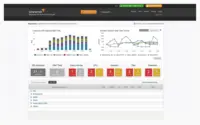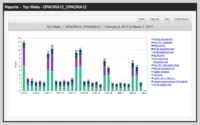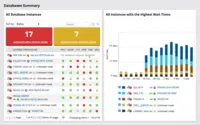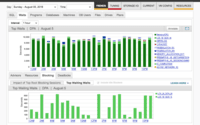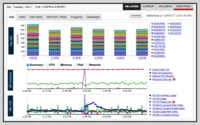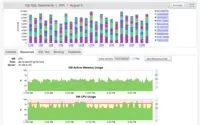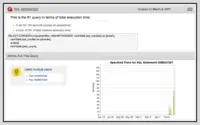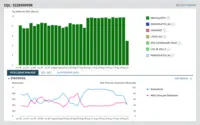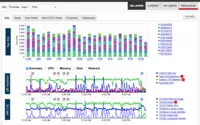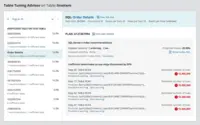Overview
What is SolarWinds Database Performance Analyzer?
SolarWinds Database Performance Analyzer (DPA) enables deep visibility into database performance and expert advice for performance optimization and tuning.What can you monitor with DPA? OracleOracle ExadataOracle EBSMicrosoft SQL Server Azure SQL DatabaseAzure SQL Database Managed InstanceMySQLDB2 SAP ASE AuroraMariaDBDPA monitors…
Easy to use and provides more details on the queries
DPA Delivers Tremendous Value
Hands Down: SolarWinds Database Performance Analyzer Beats SQL Profile and Database Engine Tuning Advisor
SolarWinds Database Performance Analyzer is a great addition to your DBA and Development toolkit
SolarWinds DPA - covers all/most of your SQL monitoring needs
Top of Class Database Performance Monitoring and Tuning Advisor!
SolarWinds Database Performance Analyzer - Recommended
DPA is hell lot of a Business for Database world
SolarWinds DPA should be on every DBA's wishlist.
SolarWinds DPA is a constant companion making sense of database performance
Awesome Tool for SQL Performance Tuning
SolarWinds DPA is a great product to visually see the health of the databases and make a proactive monitoring and root cause analysis
DPA: FTW.
SolarWinds DPA saves the day every time
SolarWinds Database Performanc Analyzer - DPA Saves The Day!
Awards
Products that are considered exceptional by their customers based on a variety of criteria win TrustRadius awards. Learn more about the types of TrustRadius awards to make the best purchase decision. More about TrustRadius Awards
Reviewer Pros & Cons
Pricing
What is SolarWinds Database Performance Analyzer?
SolarWinds Database Performance Analyzer (DPA) enables deep visibility into database performance and expert advice for performance optimization and tuning. What can you monitor with DPA? Oracle Oracle Exadata Oracle EBS Microsoft…
Entry-level set up fee?
- Setup fee optional
Offerings
- Free Trial
- Free/Freemium Version
- Premium Consulting/Integration Services
Would you like us to let the vendor know that you want pricing?
28 people also want pricing
Alternatives Pricing
What is SolarWinds SQL Sentry?
SolarWinds SQL Sentry is designed to help data professionals optimize SQL Server database performance in physical, virtual, and cloud environments. SQL Sentry delivers metrics to help users find and fix database performance problems and provides scalability, boasting demonstrated success monitoring…
What is dbForge Studio (Edge)?
dbForge Studio is provided by Devart and is a universal front-end client for database management, administration and development. Devart's GUI tool provides utilities to compare, synchronize, and back up databases (e.g. MySQL, Oracle, SQL Server, PostgreSQL, etc.) with scheduling, and includes the…
Product Details
- About
- Integrations
- Competitors
- Tech Details
- Downloadables
- FAQs
What is SolarWinds Database Performance Analyzer?
- Oracle
- Oracle Exadata
- Oracle EBS
- Microsoft SQL Server
- Azure SQL Database
- Azure SQL Database Managed Instance
- MySQL
- DB2
- SAP ASE
- Aurora
- MariaDB
What makes DPA stand out:
- Quick, easy, and reliable performance
troubleshooting available in real time and historically
- Machine learning anomaly analysis to bring intelligence to go beyond traditional threshold based analysis
- Find inefficient workloads, aggregated by table, for indexing opportunities—an “X marks the spot” tuning analysis
- Cross-platform database support for a single-pane-of-glass view into your environment
- Blocking analysis: what is blocking and a hierarchy of what is being blocked, plus overall impact
- PerfStack™ integration with other SolarWinds products for more complete visibility (applications, servers, storage, hypervisor, network, and more)
- Agent-less architecture with the ability to scale from a few instances to thousands, low 1% average overhead
SolarWinds Database Performance Analyzer Features
- Supported: Database monitoring
- Supported: Tuning advisors for queries, workload, and indexes aggregated at the table level
- Supported: Correlated resource metrics for easy diagnosis of hardware constraint impacts on end-users
- Supported: Detailed blocking analysis for contention bottlenecks
- Supported: I/O activity tracking at the drive/mount and file level
- Supported: Alerts and reports
- Supported: DPA Central to manage large and/or distributed environments
- Supported: Always On Availability Group and RAC insights
SolarWinds Database Performance Analyzer Screenshots
SolarWinds Database Performance Analyzer Videos
Watch Product Overview
SolarWinds Database Performance Analyzer Integrations
- SolarWinds Server & Application Monitor
- SolarWinds Virtualization Manager (VMAN)
- SolarWinds Storage Resource Monitor (SRM)
- SolarWinds Network Performance Monitor (NPM)
- SolarWinds NetFlow Traffic Analyzer (NTA)
- SolarWinds Network Configuration Manager (NCM)
- SolarWinds IP Address Manager (IPAM)
- SolarWinds VoIP & Network Quality Manager (VNQM)
- SolarWinds Web Performance Monitor (WPM)
- SolarWinds User Device Tracker
SolarWinds Database Performance Analyzer Competitors
SolarWinds Database Performance Analyzer Technical Details
| Deployment Types | On-premise, Software as a Service (SaaS), Cloud, or Web-Based |
|---|---|
| Operating Systems | Windows, AWS Marketplace app |
| Mobile Application | No |
SolarWinds Database Performance Analyzer Downloadables
Frequently Asked Questions
Comparisons
Compare with
Reviews and Ratings
(227)Community Insights
- Pros
- Cons
- Recommendations
User-Friendly Interface: Users appreciate the SolarWinds Database Performance Analyzer for its straightforward and easy-to-understand interface. They find it intuitive and user-friendly, even for new users with minimal training.
Real-Time Analysis and Support: The tool's real-time analysis capabilities and support services are highly valued by users. They mention that it helps them promptly identify and resolve performance issues in SQL databases, such as errors, long-running queries, or system-blocking problems.
Wide Range of Supported Databases: Users find the extensive range of supported databases to be a valuable feature of the tool. It allows them to monitor and analyze the performance of multiple databases from one centralized interface.
Dated and Confusing User Interface: Several users have expressed frustration with the user interface, describing it as dated, confusing, and difficult to navigate. They suggest that the user interface could be more user-friendly and have a reduced learning curve. Some users also mentioned that the navigation can be unintuitive and sometimes tough, and that some items can be confusing to find again. Overall, improvements in the cosmetic aspects of the user interface are needed.
Lack of Reporting Flexibility: According to some users, there is a lack of flexibility in both dashboard customization and reporting capabilities. They feel that the reporting feature needs improvement to provide more options for customization and analysis. This limitation hinders users' ability to obtain meaningful insights from their data.
High Cost: The cost of the software has been a major complaint among some users, particularly when it comes to adding additional instances. These users mention that the licensing timeline needs improvement as adding new instances becomes cost-prohibitive during certain periods of the year. The high cost associated with using this software can limit its accessibility for businesses operating on tight budgets.
Users highly recommend trying the free trial and evaluating SolarWinds DPA before purchasing. They suggest taking advantage of the free demo and training resources provided by SolarWinds. Users advise implementing SolarWinds DPA for monitoring and analyzing databases, especially for those who are just learning. The software is also recommended for DBAs in small to medium businesses and for integrating with other SolarWinds products for better data analysis. Additionally, users suggest comparing it with Idera offerings for SQL performance monitoring and highlighting it to DBAs as they will likely find value in it.
Attribute Ratings
- 8.6Likelihood to Renew4 ratings
- 9.1Availability1 rating
- 9.1Performance1 rating
- 9Usability6 ratings
- 9.3Support Rating6 ratings
- 7.3Implementation Rating2 ratings
- 7.3Configurability1 rating
- 8.2Product Scalability1 rating
- 8.2Ease of integration1 rating
- 9.1Vendor pre-sale1 rating
- 9.1Vendor post-sale1 rating
- 10Solarwinds Premier Support Rating10 ratings
- 7.3SolarWinds Smart Start Support Rating1 rating
Reviews
(1-16 of 16)- The product is great at visualizing the data you need for administration and performance tuning, making it understandable in seconds. A database like Oracle has AWR reports - many pages long, all text, hard to read. SQL Server has dynamic management views - good stuff but not so easily accessible. SolarWinds Database Performance Analyzer (DPA) lays it out so it is quickly comprehensible and actionable.
- DPA tells us what's really going on. Example: the developer says this stored procedure is running super slowly in this RDBMS but runs like lightning on this other one. They've tried to tune it to no avail. So we spend just a few minutes with DPA investigating the situation and we find that the stored proc is running fine. Instead, it is the application's attempt to access the metadata about the proc that is slow. This led to caching the metadata and now the 'slow' proc is running great! Without DPA it would have been a long time before we got to looking at the right code to tweak.
- It's great that we can use the built-in alerts functionality to create custom alerts. The custom alerts can gather information for the databases we are monitoring or from the data DPA collects which go beyond the database and into other relevant pieces like the OS, storage and the network.
- It's a great product - they do most things right. Maybe I'll say keep working on the UI so I can get to the info I need with even fewer clicks.
- One feature a competitor of DPA has that looks useful is mapping out when jobs are run and being able to map that time-wise against when problems occur.
DPA: FTW.
- Near-instantaneous feedback on problem queries
- Allows us to evaluate changes in the application or its stored procedures over time
- We can drill down to the end-user level to identify potential issues, important with > 2000 sessions daily
- Can't think of any feature or ops related issues. Prior complaints have all been addressed in newer updates.
- Only main complaint is cost -- we would adopt for other servers if the incremental cost wasn't so high for a few additional instances (we have 3 servers we would like to use DPA with, but can't justify the x3 pricing per instance).
Great for general monitoring
- Displaying baselines helps to show management how a change has affected performance positively or negatively.
- The tuning feature is helpful in showing areas that could be improved with an index or code updates.
- Wait statistics information is very helpful to diagnose database bottlenecks.
- Naming the hash takes more steps then it did in the past.
- It would be nice if there was a way to group the wait statistics by procedure.
- I search feature would be helpful.
Keep an eye on your databases using Solarwinds DPA
- The interface of the SolarWinds Database Performance Analyzer is straightforward. And it is easy to understand also.
- SolarWinds Database Performance Analyzer helps to immediately identify the performance problems of SQL Databases such as errors, long-running queries or issues that are blocking the system.
- It provides real-time analysis and support. Also, it can review issues from a historical point of view.
- Many databases are supported.
- The cost of acquiring this software is bit expensive. But it's absolutely worth.
- It takes considerable time to load.
- The reporting feature should be improved.
Invaluable, Trusted Performance Diagnostics
- Automated Collection into a queryable repository - Hands-off, detailed collection assures us that the bulk of any performance issues are noted, so that their data can be presented on-demand in a readily consumable form. Drill-into features enable detailed analysis.
- Performance Trend Analysis - Monthly top-consumers visualized in meaningful stacked-charts, with anomaly highlights and per-query, per-day detail enables hot-spot drill-down analysis.
- Resource Utilization Warnings - Best-practice warning and critical measure applied to all facets, visualized in real-time are essential features that trigger troubleshooting.
- Usability within the Trends and Current pages need improvement - Version 11 introduced a new Tuning feature, and changed the way one could quickly name a query and chose whether it would be of further interest, or is more infrastructure-oriented such that exclusion is warranted. Usability took a downward slide.
- Resource Utilization has preset periods which, for longer durations, overly smooth charts. Custom periods are much needed via the UI, rather than repository-querying.
- Storage analysis, similar to resource usage, needs custom periods and far greater ability to delineate between drives and files than v11 currently offers. (One rarely uses the Storage I/O tab)
Happy customers, much time saved
- Detecting blocking
- Showing missing index information
- Highlighting the most expensive queries being run in your system
- Giving a daily summary of issues
- Showing performance history over a long period of time
- The GUI is a little clunky, could do with updating and make it responsive
- A mobile app would be great, to keep an eye on things on the go
- Perhaps a cut-down version, as sometimes there's just TOO much information!
Useful database monitoring tool
- We use this software to identify real-time performance problems such as errors, long-running queries or problems that are blocking the system.
- We use this software to review previous SQL Server queries/performance.
- When there is an issue with any Server and I need to quickly narrow down to the right place of the root cause, this is a tool that allows me to focus on the right places and remove all sorts of noise from our data.
- Cannot easily find a query using a "text search" without detailed knowledge of the underlying SQL database "repository" that is used to display the data in each product.
- On the ad-hoc plan tab, for any given plan we have to drill down each SQL manually one by one. It would be goOd to have some kind of summary popup/tool-tip when we hover over the plan in DPA.
DPA is a helpful monitoring and analytical tool
- Predict performance across all databases
- Predict unexpected behavior
- Make a correct forecast about how much memory and CPU could be needed for a particular job
- The agent usually consumes a lot of memory
- High cost, since it is charged per instance.
- An efficient and intelligent search feature would be helpful.
- Simple and intuitive to navigate.
- Provides Top queries and makes good recommendations that are accurate.
- Good reporting use for C-Level colleagues who don't understand the techincal side of Databases.
- Having a search bar to search for particular SQL code would be useful, Especically when attempting to find a new SQL Hash name on a fixed stored proc
SolarWinds - we understand the network better
- Monitor performance
- Check for errors
- Give a clear view of the DB
- Simple GUI
- No Support for SAP HANA
- Allow alerts to SMS
- Search feature
- Quickly points out what is slowing down our SQL server
- Provides daily statistics on most ran queries and their wait time
- Operates flawlessly with no maintenance
- Sometimes it cannot tell the SQL query text - I believe its when Entity Framework SQL is being ran
- Email notification when a SQL statement starts "killing" the whole server
- Full text search of specific SQL termS in all of the SQL code that it has captured
I am ineffective without DPA
- I have used it to demonstrate disk issues to server admins by showing them the drastic increase in DB Commit times which turned out to be a failed NIC.
- I routinely use it to identify blocking sessions to verify ETL job issues.
- I use the waits and the top SQL to monitor system performance issues.
- I would like to have some visibility into the alert log in DPA.
- I would like to have tablespace/datafiles information regarding space and items contained in them.
Great DB monitoring tool for performance improvements
- Low overhead on monitored instances.
- Ability to monitor both on-prem as well as cloud instances.
- Setup tutorials could have been more simplified like how to set-up alerts and so.
- DPA should have a feature where I can text search. That's just not good :(
- Excellent overall view of database performance from the standpoint of SQL wait times. The main page for each database clearly displays the "pain points," if any.
- Ability to "drill down" to analyze particular problems in detail.
- Annotations provide a clear marker of changes so that any effect may be clearly seen.
- No PostgreSQL support.
- No ability to see a historical listing of annotations. Once annotations roll off the 30-day window, they are no longer accessible.
- There is no "timezone awareness" for global monitoring. All times are local to the area where DPA is run; this can throw off remote staff. We have sometimes created annotations at the incorrect time.
- In certain cases, the GUI gets cumbersome. This is especially true in the new (version 12) screen which shows SQL details.
- The screen presentation often doesn't lend itself to copy-paste for data to go into an email, documentation, etc.
- No facility for tracking unused or seldom used indexes.
- No integration with Oracle's Diagnostic and Tuning Pack features.
1. As a supplement to Oracle's Diagnostic and Tuning Pack features in OEM. It displays database status in a more comprehensive way and from a different angle than OEM. The two tools together provide a particularly powerful ability for DBAs to keep an eye on database performance.
2. Because it is much easier to use than OEM, it is particularly suitable for use by junior helpdesk and DBAs.
Just my view on Solarwinds DPA. Not worth it to me.
- It can tell you the amount of wait time on the SQL instance.
- It can help you find poor performing queries (by wait time) and give suggestions on the fix.
- It has a decent overview/dashboard page that can alert you to issues across all covered instances.
- It focuses on tracking/reporting the wait time statistic as the core measurement for performance. I think to most DBAs and SQL Developers, wait time is a symptom of an issue, not the root cause. I would prefer this premise be changed to track different issues that get closer to the heart of the issue.
- "Solutions" to wait time issues that the system suggests is simply canned responses by each wait type. This is incredibly unhelpful when tracking specific issues; for instance, a single query that is not performing well.
- Navigating the UI is incredibly frustrating. Trying to click a wait bar and navigating to a SQL query by its hash is rather obnoxious as well. Hovering over every hash to find the query you might be looking for is just a pain.
- Combining multiple search patterns is nearly impossible by any known means. For instance, I want to know information about queries on a database, by user, not by wait type. I have a page for queries against a database and I have a page for queries ran by a specific user. But I need ways to combine these quickly to find things.
- Completely absent features like tracking SQL Agent jobs and maintenance plans would be a huge help.
- An easier way to get to and use the "Current->Active Sessions." Currently running (or blocked) transactions are some of the most helpful tools I can have when determining issues. Focusing more on this feature would be a big plus.
- Reports are halfway useless. It seems like they only give me the options to show what I can view in the UI already, instead of extending functionality. If I need to write every report I want with a SQL Query, then what did I need to buy this tool for in the first place?
- More high-level information on the dashboard could take up some unused space. Things like: data file size, log size, agent jobs running/failed, etc could all be beneficial to show at a high level instead of a bunch of arbitrary green check marks.
- One of the other big issues I have is when a blocking transaction goes unnoticed for a while. It takes up so much of the 'wait time' graphs that other bars are basically flat. I know there is a way to make it so that query is ignored in the wait bar graphs, but finding that option is a problem. And, I don't really want to ignore it all the time. I want to ignore the single huge chunk that was being blocked a week ago so I can continue monitoring for issues with it. The other thing is that when a blocking transaction occurs, a bunch of other queries rack up massive wait time too, which just compounds the problem.
DPA - an esy to use and invaluable tool for a DBA or a software engineer professional.
- No agent required on a server, which allows us to easily switch a monitoring target.
- Integration with a VM Hosting software, so a correct decision could be made on sudden resource utilization spikes.
- Capturing a live execution plan for further analysis.
- Historical monitoring data is available for an extended time period.
- Increase a query name file size, so the names could be more meaningful and allow for distinguishing different versions of the same query easier.
- Would be nice to see captured parameters for a query, when the usual execution plan was changed.
- On the statistical/historical site: highlight rarely used indexes.

